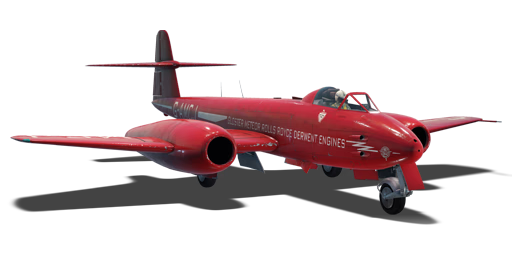



The Meteor F Mk.8 Reaper is a premium British jet fighter. It was introduced in Update 1.85 "Supersonic" as a premium pack in the Gaijin store, but was discontinued after War Thunder's 7th Anniversary. It was later reintroduced as a premium purchasable for Golden Eagles after War Thunder's 8th Anniversary.
The Reaper is a dedicated ground-attack variant based on the 'standard' Meteor F Mk.8 (G.41K) fighter-bomber which did not progress beyond its prototype stage. Thanks to a number of modifications, it would have been capable of carrying twice the payload of the standard Meteor F.8. However, combat experience of the Meteor F.8 in Korea showed that the base type had reached its technical limitations and would have been outclassed in any future conflict; the appearance of more modern types such as the Hawker Hunter and Supermarine Swift - and equivalent foreign designs - led to a loss of interest in the type.
flaps
flaps
flaps
brake
| Belt | Belt filling | Armor penetration (mm) at a distance: | |||||
|---|---|---|---|---|---|---|---|
| 10 m | 100 m | 500 m | 1000 m | 1500 m | 2000 m | ||
| HEI/SAP-I/T | 21 | 19 | 14 | 9 | 5 | 4 | |
| AP-T/HEI/SAP-I | 36 | 33 | 24 | 15 | 10 | 7 | |
| SAP-I/HEI/AP-T/HEI/SAP-I | 36 | 33 | 24 | 15 | 10 | 7 | |
| AP-T/HEI/T | 36 | 33 | 24 | 15 | 10 | 7 | |
| AP-T/SAP-I/HEI/AP-T | 36 | 33 | 24 | 15 | 10 | 7 | |
| HEI/SAP-I | 22 | 20 | 14 | 9 | 6 | 4 | |
12 × RP-3 rockets
8 × RP-3 rockets
8 × RP-3 rockets
8 × RP-3 rockets
8 × RP-3 rockets
8 × RP-3 rockets
8 × RP-3 rockets







 2 x (130 / 375 / 600) %
2 x (130 / 375 / 600) % 
 2 x 202 %
2 x 202 % 

Flight performance | |
|---|---|
Survivability |
|---|
Weaponry | |
|---|---|